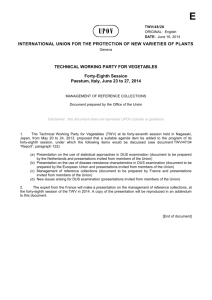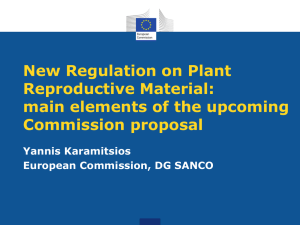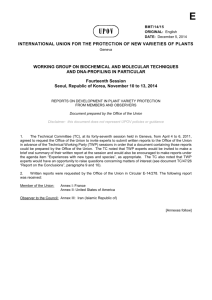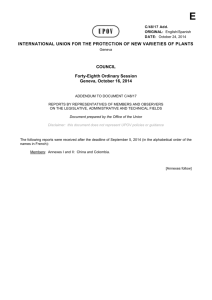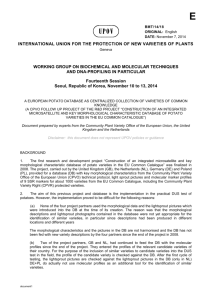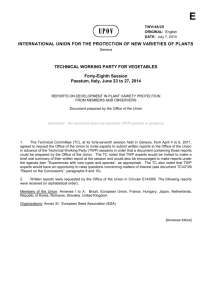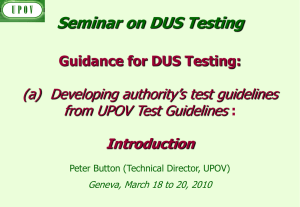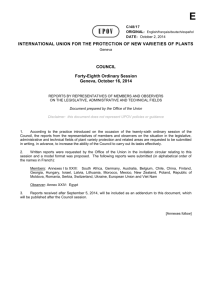TWV/47
advertisement
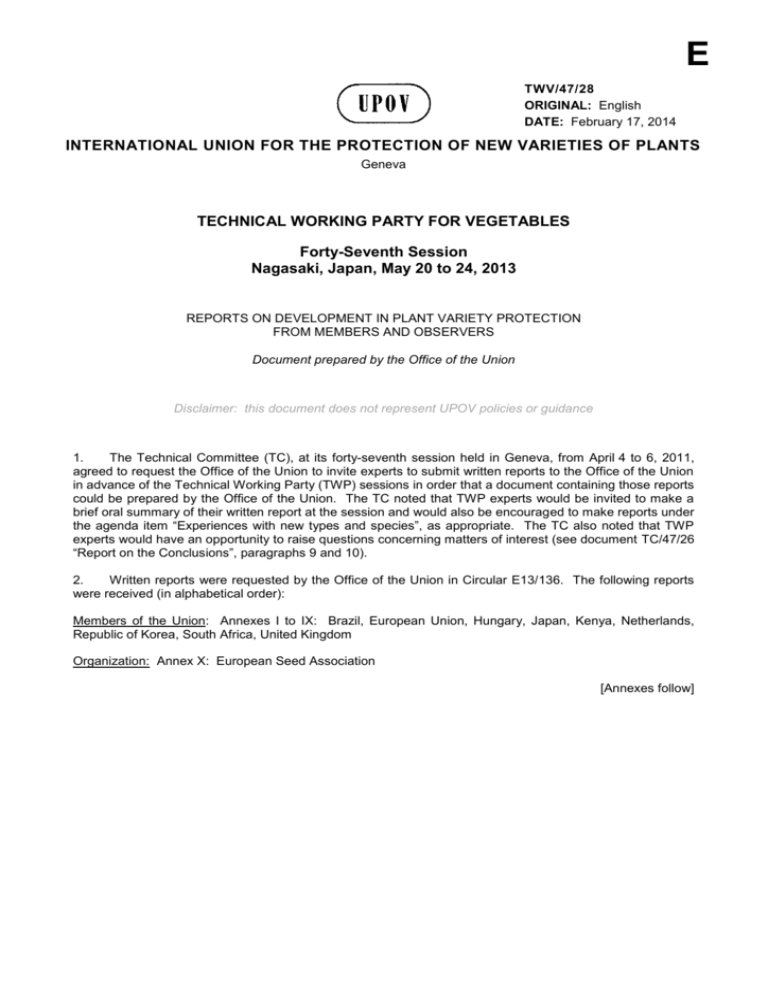
E TWV/47/28 ORIGINAL: English DATE: February 17, 2014 INTERNATIONAL UNION FOR THE PROTECTION OF NEW VARIETIES OF PLANTS Geneva TECHNICAL WORKING PARTY FOR VEGETABLES Forty-Seventh Session Nagasaki, Japan, May 20 to 24, 2013 REPORTS ON DEVELOPMENT IN PLANT VARIETY PROTECTION FROM MEMBERS AND OBSERVERS Document prepared by the Office of the Union Disclaimer: this document does not represent UPOV policies or guidance 1. The Technical Committee (TC), at its forty-seventh session held in Geneva, from April 4 to 6, 2011, agreed to request the Office of the Union to invite experts to submit written reports to the Office of the Union in advance of the Technical Working Party (TWP) sessions in order that a document containing those reports could be prepared by the Office of the Union. The TC noted that TWP experts would be invited to make a brief oral summary of their written report at the session and would also be encouraged to make reports under the agenda item “Experiences with new types and species”, as appropriate. The TC also noted that TWP experts would have an opportunity to raise questions concerning matters of interest (see document TC/47/26 “Report on the Conclusions”, paragraphs 9 and 10). 2. Written reports were requested by the Office of the Union in Circular E13/136. The following reports were received (in alphabetical order): Members of the Union: Annexes I to IX: Brazil, European Union, Hungary, Japan, Kenya, Netherlands, Republic of Korea, South Africa, United Kingdom Organization: Annex X: European Seed Association [Annexes follow] TWV/47/28 ANNEX I BRAZIL 1. The National Plant Variety Protection Service (SNPC), of the Ministry of Agriculture, Livestock and Food Supply (MAPA), is the national authority for the examination of applications and for granting plant breeders’ rights in Brazil. 2. In 2012, SNPC received 315 applications: 190 for agricultural crops, 53 for ornamentals, 24 for fruit crops, 15 for vegetables, 18 for forest trees and 15 for forage crops. 3. From these 17 applications for vegetables, 9 were for Lettuce, and 3 each for melon and tomato. 4. It is also important to point out the increasing of PVP vegetable applications by non-residents (13 out of 17 applications). All of them are from the Netherlands. [Annex II follows] TWV/47/28 ANNEX II EUROPEAN UNION (EU) Applications for the CPVRs In 2012, the Community Plant Variety Office of the European Union (CPVO) received 2868 overall applications which represented a decrease of 10% compared with the previous year. Applications for vegetables over the same period were 448, which was just 12 less than a year earlier. The most important species were lettuce, tomato, pepper, French bean, pea, cucumber, and melon in that order. In the first quarter of 2013, the CPVO received 973 overall applications representing an increase of some 32% as compared to the same period of last year. The increase in the number of applications is observed for all crop sectors and is even substantially higher – 62% - in vegetables. As from 1 January 2013, the application fee has been lowered from 900 to EUR 650. The decrease was officially announced in November 2012 and may - at least partly - explain the fluctuation in application numbers. Rights granted and titles in force The CPVO granted a yearly record number of 2640 plant variety rights in 2012 out of which 472 rights for vegetable varieties. This was even slightly more than the number of vegetable applications in the same year. In the first quarter of 2013, 746 rights were granted out of which 88 in the vegetable sector. At the end of 2012, there were a total of 20 362 Community plant variety rights were in force, i.e. 1 463 more than at the end of 2011. Online filing The CPVO launched the online application system in March 2010. The online applications reached 65% of the total number of applications filed in the first trimester of 2013. In the vegetable sector, out of 199 applications received in the first quarter of 2013, 139 were filed via the online system. Quality Audit Service Following the implementation of the so-called “one key, several doors” principle, whereby DUS test reports produced by any “CPVO-entrusted” authority in the EU are accepted for listing or protection purposes throughout the Community, an independent technical audit of the CPVO continued audits. The first round of the three-year auditing cycle was finalized by the end of 2012. In total 30 audits were conducted – for some examination offices twice – resulting in 26 entrusted examination offices. Taking into account that for the large majority of vegetable species more than one examination office is competent to carry out DUS examinations for the same crop, the enhanced harmonization of the DUS testing, continues to be a permanent task of the Office. Vegetable experts’ meeting of 2012 A meetings with vegetable experts was held in Angers in December 2012. Revisions of the technical protocols for French bean, spinach, radish/black radish, artichoke/cardoon, parsnip and tomato (partial revision) were prepared, all of which were subsequently adopted by the CPVO’s Administrative Council in February 2013. The CPVO continued discussions with its entrusted examination offices in vegetables regarding the possibility to extend the principle of parallel/staggered DUS testing, with two independent growing cycles over one year. This would normally take place in two separate test locations and be applicable only to certain crops. The CPVO was meant to report at the present TWV/47 meeting on the survey within the European Union on the levels of uniformity according to the state of expression of obligatory disease resistance characteristics and varieties not bred for having such disease resistance. Due to an ongoing similar case filed by Slovak breeders at the Slovak constitutional court, the CPVO in agreement with its examination offices and the European Seed Association (ESA), decided not to proceed with such a survey until such time as there had been a court ruling on the case. The CPVO commenced brainstorming discussions though on the need for obligatory (asterisked) disease resistance characteristics within its vegetable protocols. This includes evaluating alternatives for making better use of disease resistance characteristics to improve the performance of the DUS test. Discussions on the matter are expected to continue throughout 2013. Research and Development (R&D) projects The CPVO formally approved in 2012 the co-funding of the R&D project ‘Harmonization of vegetable disease resistances 2’ (Harmores2), coordinated by GEVES (FR), with project partners from the Czech Republic, Germany Hungary, the Netherlands, Spain, the United Kingdom and ESA. The project is a follow-up to the earlier ‘Harmonization of vegetable disease resistances’ completed in 2008, although the new project deals with seven disease resistances in pepper, pea and lettuce. After agreement amongst the project partners on TWV/47/28 Annex II, page 2 the races/isolates and example varieties which would be used, the first year of the project has focused on the description and comparison of the existing test for these resistances. The second annual meeting amongst the partners to discuss progress on the project, took place in Angers the week before the TWV/47 session New EU Member State On 1 July 2013, Croatia will join the EU: all Community plant variety rights already granted will then also be valid on the territory of Croatia. The CPVO has placed a document on its website informing stakeholders on the consequences Croatia’s accession to the EU may have in the area of plant variety rights. [Annex III follows] TWV/47/28 ANNEX III HUNGARY The number of application is stable. In 2013 a total of 118 vegetable had been received for national listing. The highest numbers were at tomato (33) and pepper (32). More than half of the pepper applications were from Hungarian breeders. Moreover quite a high number of pepper applications are tested in cooperation with the neighboring countries, mainly for the Czech Republic. The number of PVP applications at vegetables are low. Mushroom species as Agaricus bisporus, Pleurotus ostreatus and some ornamental species are tested for Community Plant Variety Rights. Resistance tests of vegetable species are made with the help of experts from the Directorate of Plant Protection of our office, from the Plant Protection Institute of the Hungarian Academy of Sciences and from the Corvinus University. The inoculums are maintained and prepared for infections by them, but the infections and notations are made by our experts. The Hungarian Patent Office takes part in the “Harmonization of resistance tests to diseases for DUS testing – 2” project supported by the Community Plant Variety Office of the European Union (CPVO) with pepper Tobamovirus and PVY tests. Plant variety testing became an independent vice-presidency at our office. CPVO quality audit had been made at the beginning of May. There were not any nonconformities at vegetables. [Annex IV follows] TWV/47/28 ANNEX IV JAPAN 1. Number of application and granted in 2012 (1) Number of applications Year Number (2012/2011) (2012/2011) (99%) Vegetables and Mushrooms V: 77, M: 20 V: 65, M: 18 2011 2012 1,126 1110 1978 to 2012 27,975 - V: 1792, M: 523 - V: 84% M: 90% Top 5 Vegetable and Mushroom crops in 2012 Lettuce:15 Strawberry:12 Soya bean:7 Buna Shimeji:6 Tomato:4 Welsh Onion:4 TOTAL:65 (2) Number of granted Year Number (2012/2011) (2012/2011) (77%) Vegetables and Mushrooms V: 88, M: 20 V: 76, M: 5 2011 2012 1,139 881 1978 to 2012 22,167 - V: 1493, M: 445 - V: 86% M: 25% Top 5 Vegetable and Mushroom crops in 2012 Lettuce:26 Tomato:9 Strawberry:9 Soya bean:8 Pepper:4 TOTAL:76 2. Average examination duration (from application to registration) 2011 2012 2014 (target) 2.4 year 2.36 year 2.3 year 3. Japanese Test Guidelines harmonized with UPOV TG (in 2012) TWP TWV Other TWPs Genera and Species Lettuce (partial revision) Bougainvillea, Canna, Gaura, Lilium, Oenothera, Serruria, Torenia Vriesea Camellia sinensis, Fagopyrum esculentum, Malpighia emarginata Website: http://www.hinsyu.maff.go.jp/en/en_top.html [Annex V follows] TWV/47/28 ANNEX V KENYA 1. PLANT VARIETY PROTECTION 1.1. Situation in the Legislative field The National Plant Variety Protection in Kenya is provided under the Seeds and Plant Varieties Act (CAP 326) of 1972, which became operational in 1975 and was revised in 1991. Official regulations to guide the implementation of PVP service were put in place in 1994 and the office to administer the PVP was established in 1997 and has functioned under Kenya Plant Health Inspectorate Service (KEPHIS) since 1998. Kenya acceded to UPOV under the 1978 Convention on 13th May 1999. The Seeds and Plant Varieties Act (CAP 326) has been amended to conform to the 1991 Act of the UPOV Convention and Kenya has initiated the process of acceding to the 1991 Act of the UPOV Convention. 1.2. Extension of protection to further genera and species Kenya extends Plant Variety Protection to all plant genera and species, other than algae and bacteria. At the moment, a total of sixty one (61) taxons of selected plant species have been registered for protection in the country. 1.3. Case law Under the Kenyan Seeds and Plant Varieties Act (Plant Breeders Rights) applications for Plant Breeders Rights are required to be published in the Kenya gazette, to allow those opposing any applications or grant of rights, to make the objections and make representations to the Authorized Officer – KEPHIS. The Authorized Officer determine the hearing of such representations but any applicant aggrieved by the decision of the Authorized Officer may appeal to the Seeds and Plants Tribunal and if further aggrieved by the decision of the Tribunal, final appeal to the High Court. From the time of inception of the PVP service in Kenya, a total of forty eight (48) applications for PBRs have been contested. Out of these, cases for thirty one (31) applications have been heard and determined by the Authorised Officer. Hearing of representations for the remaining cases for seventeen (17) applications is ongoing. So far there has been no case that has been challenged through the Tribunal. 2. Cooperation in Examination As per UPOV Article 32 on Special Agreements, The PVP office in Kenya has entered into international cooperation with other UPOV members in the utilization of the existing DUS examination reports notably, European Community – Community Plant Variety Office Raad voor plantrassen (Board for Plant Varieties) – Netherlands The Plant Breeders’ Rights Council – Israel Commissioner of Plant Variety Rights - New Zealand The registrar, National Department of Agriculture – South Africa Bundessortenamt - Germany 3. Situation in the Administrative fields The administrative structure, office procedures and systems within the PVP office in Kenya remains the same. All correspondences need to be addressed to:The Managing Director Kenya Plant health Inspectorate Service Headquarters, Oloolua Ridge, Karen P. O. Box 49592-00100, Nairobi Tel. +254 20 3597201 or +254 20 3597203 Cell: +254 723 786 779 or +254 733 874 141 e-mail: director@kephis.org website: www.kephis.org TWV/47/28 Annex V, page 2 4. Situation in the Technical field Since the inception of the PVP office in Kenya, a total of 1189 applications for Plant Breeders’ Rights have been received. Figure.1.1. below shows the status of such applications. 416 Granted Titles 170 Processed Titles Application for Test Reports requested 101 97 Applications under DUS Contested applications Applications to be Gazetted 17 42 190 Applications withdrawn Incomplete applications 156 Reasons for withdrawn applications by the breeders include reduced interest in a variety by consumers and availability of better varieties to the breeder. Those applications either not meeting the novelty requirement and / or fail the DUS testing are withdrawn by the authorized officer – KEPHIS. The incomplete applications are either due to missing supportive documents that must accompany the application or due to non-payment of the application fee by the applicant. Applications approved for granting of PBR titles are those DUS examination report has been finalized and confirmed to be positive but awaits payment of grant for PBR certificate fee by the applicant. The date of payment of this fee becomes the official commencement date of protection of that variety in Kenya. To date the total number of PBR Grants awarded is 415. Fig. 1.2 shows the status of such granted titles. TWV/47/28 Annex V, page 3 Sales granted titles applications withdrawn The Office is in the process of domesticating most of the UPOV DUS Test Guidelines into National DUS testing Protocols. 5. Activities for the promotion of Plant Variety Protection The PVP office in Kenya has been actively involved in a number of activities for the promotion of Plant Variety Protection in the Country and within the Africa region. Some of these promotional activities includes: Dissemination seminars on awareness creation on PVP services in the country. These seminars targets National Agricultural research institutions, Universities, policy makers, Agricultural extension staff as well as the larger farming communities. The office has been instrumental in the development and launch of the Seed policy in the country and in the development of institutional intellectual Property (IP) Policy for various institutions. Within the region, the Office has been instrumental in terms of Technical assistance in the establishment of the PVP Office in the United Republic of Tanzania and Zambia. The Office has also offered DUS expertise in training of delegates from AFSTA, ASARECA, Burundi and Somalia The office is also taking lead in the harmonization of variety testing within the East Africa cooperation. The Office is also part of the drafting team developing the PVP legal framework for ARIPO [Annex VI follows] TWV/47/28 ANNEX VI NETHERLANDS Number of applications received In 2012, 1660 applications were received for testing for the first year for national listing and national and European Plant breeders rights. In brackets the difference with 2011: Ornamentals 874 (-12%) Agriculture 131 (-5%) Vegetables 655 (-10%) Total 1660 (-11%) This seems to be a drastic decrease compared to 2011, but we must bear in mind that the number in 2011 was 15% higher in relation to 2010. Furthermore, the number of applications received in 2013 up till now, shows a tendency to increase again compared to 2012. Training in DUS related activities The sharing of knowledge is important in order to work on a global, harmonized and strong Plant Breeders right system for the benefit of society. Naktuinbouw contributes to this principle on different levels. Naktuinbouw is involved in bilateral projects to exchange knowledge and to train staff of countries that are working in or on Plant Breeders Rights systems. In 2012 the projects with Indonesia and Vietnam were finished. The cooperative program on the introduction of PBR in Ethiopia (which is not yet a member of UPOV), including institution building, awareness sessions and a training program on DUS, was successfully finalized with the ratification of a new seed law in January 2013 soon to be followed by a law on PBR. Finally, eight employees of Naktuinbouw (Kees van Ettekoven together with 7 crop specialists) attended several meetings about exchange of views regarding DUS-examination in India. Annually, Naktuinbouw, with the help of UPOV and CPVO, is organising the PVP course in Wageningen. In 2012 24 participants from 19 countries participated in this two week training. The coordinator of the PVP-course, Mr. ArndJan van Wijk retired in 2011 and this task is now fully taken over by Mrs. Laura Pinan Gonzales. Two colleagues are tutors in the UPOV distance learning course. The set-up of the new distance learning course DL-305 “Examination of Applications for Plant Breeders’ Rights” (a joint effort of UPOV, Naktuinbouw and experts of other UPOV countries) resulted in the preparation of a first draft, prepared by the UPOV Office in March 2013. This second distance learning course is aimed at the DUS test itself. This more practice related course will combine the knowledge from the TGP- documents with practical examples out of the actual tests. In 2012 Naktuinbouw received again colleagues as interns from the Republic of Korea (2) and China. The colleagues worked together with Naktuinbouw colleagues and thus learn the details of the DUS test work as it is performed in the Netherlands. The use of the Naktuinbouw helpdesk stabilised. Colleagues from all over the world find this opportunity to ask DUS related questions. Registration The online version of the Netherlands Register of protected varieties (NRR) was further optimized with the uploading of data of agricultural crops for National Listing. The new i-portal for DUS-applications at Naktuinbouw is on the air since November 2012. Now, the applicants can online follow the progress of the DUS-examination of their applications for PBR and/or National Listing. Quality System The accreditation according to ISO 17020 for 20 major species was converted into the CPVO-entrustment system for all ca. 950 species. Research projects (highlights). DNA-dbases: In Phalaenopsis the first results of the use of DNA-techniques in the management and renewal of the reference collection were positive. Naktuinbouw and other partners are working on the setup of a joint DNA database in this crop as well. In lettuce however, the results showed that DNA analysis was not suited for the management of the collection. Naktuinbouw participated in the enlargement of the DNA-database in potato. TWV/47/28 Annex VI, page 2 Other: Progress was made in the use of electronic registration of observations and measurements in the field. In March 2013, a number of new ‘handhelds’ were bought for use in the field. International Cooperation With GEVES: Cooperation was started for variety documentation in three vegetable species. Furthermore, cooperation in resistance testing was initiated and cooperation in possibilities for automation of RHS-measurement of color (also together with CPVO) With UPOV: In June 2012 the annual meeting of the UPOV-TWV was successfully organized at the Floriade in Venlo. Ring test: In July 2012 The Netherlands hosted a ring test meeting for DUS testing of potato organized by CPVO among the 9 entrusted Examination Offices for potato. It was an eye opener for the participants to see the different results in light sprout observations which were expected to be more harmonized because of the highly controlled conditions. Infringement cases In an increasing number of cases, Naktuinbouw is asked to assist in collecting plant material in possible infringement cases under Civil Law. In several cases we are also asked to carry out morphological comparison and DNA analysis of varieties involved in these cases. Naktuinbouw accept these questions only under precise prerequisites: The request must be organized by the court. We can only act in a neutral way, i.e. as expert advisor who accompanies a bailiff. Under full payment of real costs. As far as possible, we prefer a combination of a morphological approach and a DNA analysis. At the moment, we have about 5 of such cases per year. In the meantime, some (court) cases have been finished. Some other cases were withdrawn, as both parties finally reached mutual agreement. In general, we can conclude that these procedures are very effective in enforcement of Breeders’ Rights. Miscellaneous Naktuinbouw completed a short film about breeders’ rights which can be viewed on our website http://www.naktuinbouw.nl/en/news/film-plant-breeders-rights . Mr. Krieno Fikkert, the secretary of the Dutch Board of Plant Varieties retired in 2012 and we welcomed his successor, Mr. Kees Jan Groenewoud. The board of Naktuinbouw accepted the renewal of the oldest part of our greenhouses. This activity will start in May 2013. During the annual UPOV TC meeting in March this year, it was proposed to the Council that it elect Mr. Alejandro Barrientos-Priego (Mexico) as new Chairperson and Mr. Kees Van Ettekoven (Netherlands) as new Vice-Chairperson of the TC for the forthcoming three-year term. TWV/47/28 ANNEX VII REPUBLIC OF KOREA 1. Plant Breeder's Right Total number of application as of 31 December 2012 had been reached 6,233 and among them, 4,277 varieties were registered and 240 varieties were rejected since implementation of PVP system in 1998. Last year we received 606 applications, among them 157 varieties were vegetables such as Capsicum (26), strawberry (23), radish (19), chinese cabbage (18), watermelon (10). 2. Plant Variety Protection Law In the Republic of Korea, Plant variety protection has been enforced by Seed Industry Law which covers PVP and Seed Certification since 1997. Recently, Plant Variety Protection Law was separated from Seed Industry Law to cover the PVP matter only. The law will come into effect from June this year. 3. International Cooperation KSVS will provide PVP training course for the experts from Asian or African countries which are introducing or developing PVP system for 3 weeks in June 2013. [Annex VIII follows] TWV/47/28 ANNEX VIII SOUTH AFRICA With regards to applications and valid Plant Breeders’ Rights for 2012 the following is reported: An additional 16 taxa have been declared in terms of the Plant Breeders’ Rights Act during 2012 . 306 PBR applications were received of which 37% were for Agricultural crops, 23% for Ornamental crops, 34% for Fruit crops and 6% for Vegetable crops. As of December 2012, a total of 2 449 varieties had valid plant breeder’s rights in South Africa, of which 35% were for Ornamental crops, 35% for Agricultural crops, 21% for Fruit crops and 9% for Vegetable crops. The top three crops for each category are: Agricultural Crops Vegetable Crops 1. Zea mays L. (335) 1. Solanum lycopersicum L. (47) 2. Solanum tuberosum L. (77) 3. Triticum aestivum L. (77) 2. Phaseolus vulgaris L. (Garden bean) (35) 3. Allium cepa L. (38) Fruit Crops 1. Prunus persica (L.) Batsch var. nucipersica Schneid. (94) 2. Vitis L. (66) 3. Prunus persica (L.) Batsch (71) Ornamental Crops 1. Rosa L. (345) 2. Chrysanthemum L. (69) 3. Aloe L. (32) Plant Breeders’ rights granted only in 2012 are as follows: Agricultural crops: 116 Vegetable crops: 18 Fruit crops: 73 Ornamental crops: 52 [Annex IX follows] TWV/47/28 ANNEX IX UNITED KINGDOM During 2012 in the United Kingdom both the number of DUS applications and the range of crops tested showed a slight increase on recent years. On 1st April 2013 the Vegetable Section at Science and Advice for Scottish Agriculture (SASA), which undertakes DUS testing in Vegetables for the United Kingdom, became part of “Potato and Vegetable Crops” a branch of SASA which will now have responsibility for all variety testing (including potato) undertaken here. The United Kingdom Examination Office for DUS testing has moved within Cambridge and can now be found at: Plant Varieties and Seeds The Food and Environment Research Agency Eastbrook Shaftesbury Road Cambridge CB2 8DR United Kingdom Tel: +44 (0) 300 060 0497 http://www.fera.defra.gov.uk/plants/plantVarieties/contactUs.cfm Further database development work was undertaken aimed at better documenting and characterising crop inventories and reference collections. This work has been done in conjunction with a rationalisation of the SASA Quality Assurance system (under ISO 9001:2008) and will facilitate the CPVO Entrustment audit due in July 2013. [Annex X follows] TWV/47/28 ANNEX X EUROPEAN SEED ASSOCIATION (ESA) The Annual Congress of ESA took place from October 14 – 17 in Brussels (BE). A record of more than 750 participants attended the meetings clearly showing the increased interest in the event. Mr Christoph Amberger (KWS – DE) stepped down as ESA President and was succeeded by Mr Gerard Backx (HZPC – NL). ESA is focusing on the implementation of the European Seed Treatment Assurance Scheme to assure safe handling of seed treatment and treated seed. As follow up of the adoption of the ESA Position paper on Intellectual Property Rights ESA is in the process of developing a patent data base to provide information on patents linked to specific varieties. This data base will be freely available as from July 1st. On both issues more information can be found on the ESA website: www.euroseeds.org. Registration for the 2013 ESA Annual Meeting has been opened. This year the ESA AM will take place from October 13-16 in Warsaw (PL). On May 6th the Commission and adopted its proposal on the so-called package on Plant Reproductive Material (PRM). This package revises the EU legislation on Plant and Animal Health, Plant Reproductive Material and Food and Feed Control. The proposal contains the main pillars regarding variety identity and seed certification as well as provisions for the marketing of conservation varieties. The PRM package will now enter into discussions with the European Council and the European Parliament and after adoption will rule the European seed market for the next generation (BS). [End of Annexes and of document]
